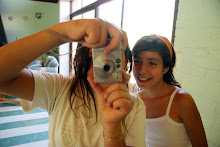
Leaving the hogar with our photography taller serves two purposes: first, it makes the girl's photography more exciting. On the move in this big city keeps new people and events always in front of their lenses, and they have a million chances to try new techniques and ideas, to overcome fears of pressing the shutter in public or photographing people they don't know. Second, it gives the girls an opportunity to leave the hogar. Like most teenagers, these young women want to be independent, they want to go out, meet people, talk to each other, and not necessarily always be with an adult. Have a 26-year-old ask them if they want to leave the hogar for a few hours to go to the city center (or even the library) armed with their own digital camera, and you will have nearly every inhabitant of the hogar asking where they can sign up. Our excursions, for the most part, are a big hit with the four girls in the taller, and I enjoy taking them out; the responsibility of four young lives always makes me a little nervous, but it's telling the other dozens of young women that I can't also include them that complicates the process even more. There is always the underlying fear that something will happen to one of the girls, especially with the risk of flashing four shiny digital cameras around in public which just begs for attention.

Taking advantage of the fact that the girls have been on summer vacation, we have been leaving the hogar nearly twice a week. Our first excursion was to Santa Lucia, a hill decorated with beautiful staircases and fountains from which one can view the wide expanse of the city. Over an hour away in metro from the hogar, we had just over an hour at the hill which is right in the city center. I waited to pass out the cameras until we arrived just to make sure the girls wouldn't use all of the memory on their cards before we got there. We climbed nearly to the top before we had to trek back down, and each girl seemed to find her own pace along the way-- making it a little difficult to manage with a ratio of two volunteers to four girls. I almost wish we had four volunteers, one for each student, but still we're learning how to move as a group while allowing enough freedom for the girls to be creative. I think in the debate of what age levels benefit more from this particular taller, the type and amount of supervision are important factors to consider.

We've been to the Puente Alto library three times now, and they have even been so nice as to cover some small black and white printing costs for us. Because of the varying levels of computer knowledge, the instructions in Photoshop also tend to vary student to student. I end up walking down the line of computers helping each girl individually, trying to get them on more of the same level before giving directions to the group as a whole. I have started making small instruction guides in spanish with visual aids so that when they are a little more comfortable with the program they will be able to continue to discover new concepts on their own.

As a group, we sit down after each excursion and look at the most recent photographs. What the girls decide to photograph, and how they capture the image, never ceases to intrigue me. Some are more timid to speak in front of the group, but as a whole the girls seem very supportive of each other and the risks they take with their photography. I won't deny that a couple of the girls support a very keen interest in trying to collect snapshots of passing male teenagers of whom they think are irresitably rico, but they're usually too shy to follow through anyways. I choose to exercise more positive feedback on what they are doing well, and definitely find their company an unending source of entertainment and challenge. To say that we run around together always as a happy group would be misleading; each day has a different dynamic as we all continue to wade through the inevitable drama in our lives. But I will say that if even one girl has had a fun or interesting time after our taller than it's been successful. As it stands now, on the Chilean grading scale of 7-1, I would give the girls a big juicy 7 for effort.
Photographs above taken by Claudia G, Yanina, Claudia N, and Herna, respectively.










